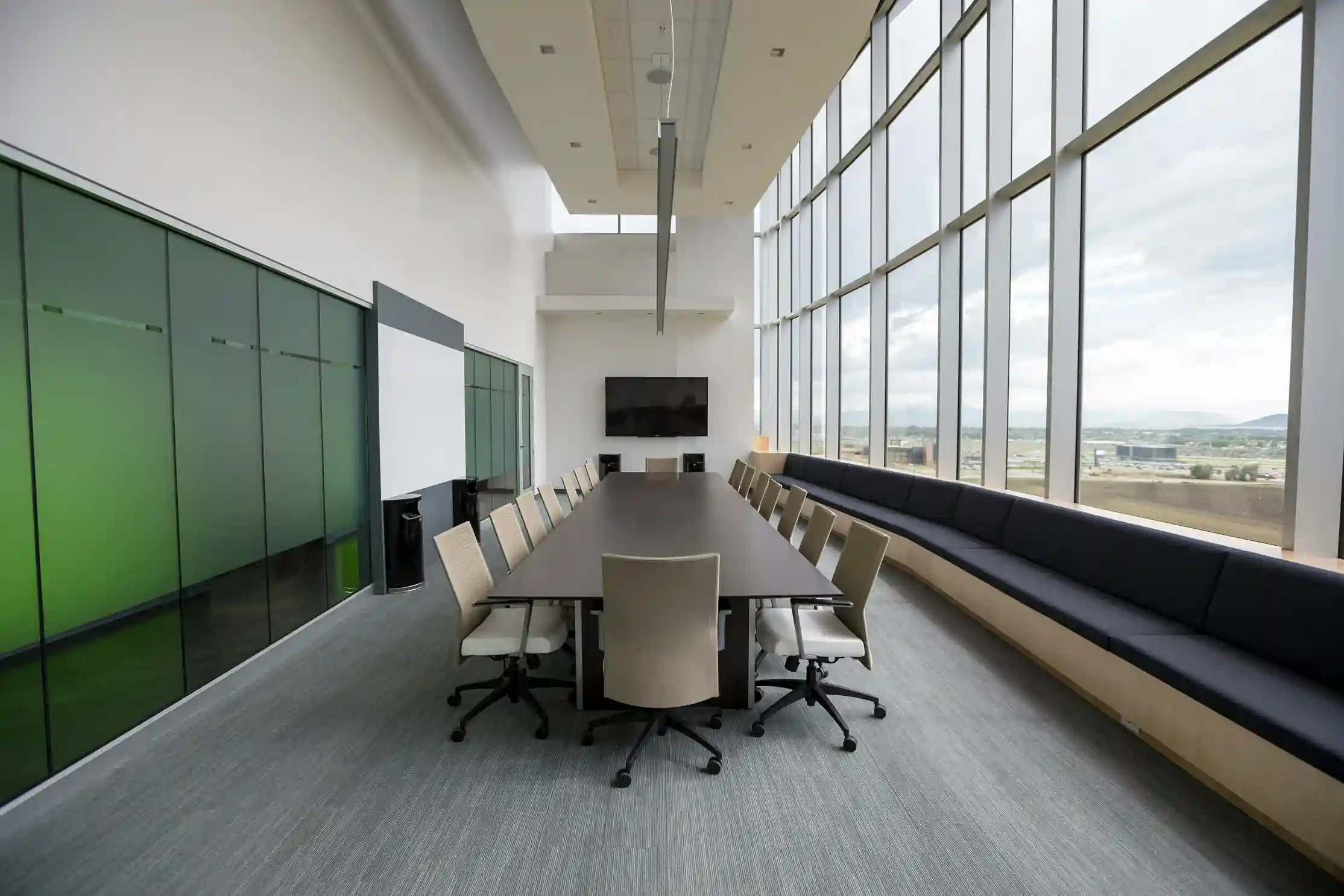
Workspace Management Software: Tips & Features To Consider
Learn essential tips and features to consider when choosing workspace management software to optimize your office environment and improve ...
Solutions
Workplace Management Solutions
Real Estate Management Solutions
Maintenance Management Solutions
Energy Management Solutions
Engineering Document Management Solutions
Asset Management Solutions
Automate campus scheduling for classes, meetings, and exams with our EMS software.
Plan and manage conferences effortlessly with EMS software to impress guests and streamline operations.
Boost workplace flexibility and maximize space use with seamless desk and room booking.
Organize workplace or campus events smoothly, creating memorable experiences.
Optimize workspace, manage allocations efficiently, and reduce costs with our space management solutions.
Deliver projects on time and within budget by improving communication, collaboration, and efficiency with our software.
Streamline lease accounting for ASC 842, IFRS, and GASB compliance.
Manage leases efficiently by tracking key dates, analyzing costs, and ensuring compliance.
Centralize data and analytics for better insights, faster negotiations, and revenue growth.
Centralize facility and asset maintenance, automate work orders, and ensure compliance with our CMMS software.
Extend asset life, reduce downtime, and prevent costly repairs with data-driven monitoring.
Prevent equipment failures and extend asset life by detecting and addressing issues early.
Make sustainable, cost-efficient energy decisions by monitoring and optimizing power consumption.
Remotely monitor and control equipment with real-time data to predict issues, boost efficiency, and reduce downtime.
Easily share and collaborate on documents, creating a single source of truth for engineers and contractors.
Manage and analyze assets across their lifecycle to schedule maintenance, reduce downtime, and extend lifespan.
Improve visibility, automate work orders, and ensure compliance for efficient facility and asset management.
Resources
Browse our full library of resources all in one place, including webinars, whitepapers, podcast episodes, and more.
Support
Looking for access to technical support, best practices, helpful videos, or training tools? You’ve come to the right place.
About Accruent
Get the latest information on Accruent, our solutions, events, and the company at large.

Discover the significance of effective workspace management, understand its advantages, and explore the leading software solution. Learn how to fine-tune a workspace to boost productivity.
Effective workspace management plays a vital role in the success of any organization. It involves arranging physical and digital spaces to support employee well-being and operational success.
This guide covers the basics of managing a workspace. It introduces software that can help to simplify the process. With the right strategy, companies can create a more dynamic and productive workspace.
Workspace management refers to organizing and improving physical and digital workplaces. The goal is to maximize productivity and profitability while reducing environmental impact. It includes various elements such as space planning, resource allocation, and technology integration to help communication and workflow.
Workspace management aims to:
Workplaces are important because they both reflect and unwittingly shape our professional identities — who we were, who we are, and who we aspire to be as workers. Our identities become intertwined with our workplaces as we accumulate milestones, memories, and life-shaping experiences.”— Harvard Business Review
The right workspace management system offers many benefits, and success can foster a dynamic and innovative environment for employees. Here are five benefits of workspace management.
With seamless space management, employees can easily navigate their workday with less friction. Valuable time is not wasted, and organizations can tap into a higher level of productivity. Tailored workspaces minimize distractions and improve efficiency.
A well-designed workspace encourages interaction and teamwork. Facilitating easier access to collaborative areas creates a culture of innovation. When employees can easily communicate, their brainpower is freed up for more progressive problem-solving.
Adaptive workspaces can quickly respond to any type of organizational change in work patterns. That means if, for whatever reason, a company needs to go remote, they are prepared. The right workspace management tool supports remote work, flexible hours, and other evolving business strategies.
Efficient use of office space reduces unnecessary overhead costs. Strategic planning software enables companies to avoid the expense of underused areas, leading to significant cost savings that can be redirected into growth and investment opportunities. This optimization ensures that every square foot of office space contributes positively to the company's bottom line.
A well-managed workspace means employees do not feel frustrated or that their time is wasted due to inefficient setups and operations. The reality is that nearly 50% of employees are looking for new jobs, and therefore, it is important not to give them another reason to be dissatisfied.
-2.avif)
Companies that optimize their workspace can create a more productive and engaging environment. Here are five actionable strategies on how to improve.
Start by zooming out and performing a comprehensive assessment of how the space is currently managed. Gather data points such as:
With this information, companies can identify pain points and make more informed decisions on how to manage their workspace. The goal is to create a more efficient, productive, and adaptable environment.
Providing flexible workspace policies means creating work arrangements for diverse work styles and personal preferences. Provide a variety of workspace types, such as quiet zones and communal areas. Utilize desk booking software for innovative approaches. The right workspace policies show employees that companies care about their desires, leading to increased job satisfaction and productivity.
As needs evolve, so should the workspace. Periodic reviews, done through a space management system, ensure the layout meets current demands. A responsive and dynamic workspace promotes a healthy, productive environment.
Advanced workspace management software like Accruent’sEMS software can streamline the management of office spaces. These tools optimize how a workspace is utilized. Automating these processes allows organizations to reduce admin overhead, improve the employee experience, and make data-driven decisions about future workspace adjustments.
In addition to providing what is expected from leading software, Accruent's EMS Software stands out through these unique key features:
Leveraging Accruent’s EMS Software means meeting and exceeding expectations through the unique integration of innovative technology and user-centric design. Excess waste of resources is one of the worst things that can happen to an organization. Employees get caught up in useless tasks. Meanwhile, companies might be investing resources in unnecessary office spaces or layouts.
With Accruent’s EMS, organizations can transform workplace productivity and satisfaction. The right information helps leaders make the right decisions in today’s fast-moving corporate environment.
Effective workspace management is essential for fostering productivity and satisfaction in the modern workplace. Solutions like Accruent’s EMS Software achieve this by streamlining operations, optimizing space usage, and improving workplace flexibility. The future of work is not just about where we work, but how we work together and build spaces that move us forward.
Workspace management software streamlines efficiency by automating routine tasks. It enables real-time tracking of resources and offers actionable insights. This allows for smarter and proactive decision-making, reduces manual errors, and ensures optimal use of space and resources. It fosters an environment striving towards productivity at the highest level.
Essential features include advanced booking capabilities for spaces and resources, comprehensive resource management, in-depth analytics for data-driven decisions, and a user-friendly interface. These key features help facilitate a smoother operational flow throughout an organization, from booking rooms to understanding employee habits and tendencies.
Organizations must recognize the advancement and possibility of automation. Workspace management helps tap into operational efficiency by minimizing costs and promoting a dynamic and flexible work environment. It addresses the challenges of the modern workplace, providing information to help companies thrive in today’s highly competitive environment.
Learn essential tips and features to consider when choosing workspace management software to optimize your office environment and improve ...
Discover expert tips on office space planning to create a highly efficient workspace. Learn how to maximize productivity with advanced space planning ...
Learn the meaning of hot desking, its benefits, and recommended software solutions. Revolutionize your workspace with this modern office trend today!
Subscribe to stay up to date with our latest news, resources and best practices.
* To unsubscribe at any time, please use the “Unsubscribe” link included in the footer of our emails.